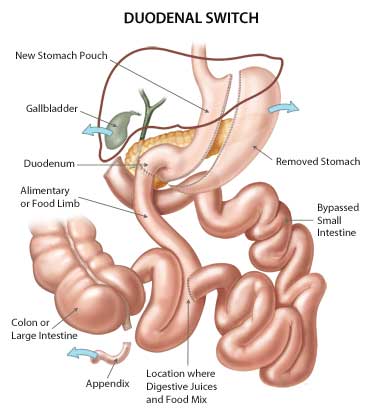
Laparoscopic Roux en Y Gastric Bypass
This is the gold standard procedure in bariatric surgery and 40 years down the line has stood the test of time. This procedure is the combination of a restrictive and a partial malabsorptive procedure.
Lap RYGB as its popularly called involves creation of a small (30-50 ml) micro pouch in the upper part of the stomach. To this pouch the cut end of the mid jejunum (Food limb) is attached. the other end (digestive juices limb)is attached to the distal jejunum. So basically it involves creating a small food pouch in the stomach (restriction part) and the stomach, duodenum and jejunum are bypassed (malabsorption part) close to 200cms.
The surgery enables its effects by :

Reducing the capacity
To eat/avoid over-eating because of the small pouch of stomach
Reducing the appetite
By bypassing the fundus of the stomach producing the hormone Ghrelin
Reducing the absorption of
food in taken
By bypassing parts of the small intestine
Increasing energy expenditure rate
By increasing levels of hormone Oxyntomodulin produced in ileum aided by bypass
Immediate remission of diabetes
By effective activation of the pancreas to secrete insulin by hormone GLP-1 fin the ileum
Permanent remission from diabetes
By reducing insulin resistance by inducing fat loss
The surgery has proven to be very effective in weight loss, even in the super-obese (BMI>50) and in patients suffering from uncontrolled diabetes, hypertension and Gastro- Oesophageal Reflux Disease (GERD). One can expect weight loss of about 70-80% of excess body weight.

The mini-gastric bypass procedure has gained popularity in recent years. The mini- gastric bypass was initially developed to reduce operating time, simplify the gold standard Roux-en y gastric bypass. The mini-gastric bypass procedure is restrictive and partial malabsorptive procedure.This means that the procedure reduces the size of your stomach, restricting the amount you can eat. The procedure also reduces absorption of food by bypassing 150-200cms of small intestines.
The surgery enables its effects by :
- Reducing the capacity to eat/avoid over-eating because of the small pouch of stomach
- Reducing the appetite(by bypassing the fundus of the stomach producing the hormone Ghrelin)
- Reducing the absorption of food in taken (by bypassing parts of the small intestine)
- Increasing the energy expenditure rate (by increasing the levels of hormone Oxyntomodulin produced in the ileum aided by the bypass)
- Immediate remission of diabetes ( by effective activation of the pancreas to secrete insulin by hormone GLP-1 fin the ileum)
- Permanent remission from diabetes ( by reducing insulin resistance by inducing fat loss)
The surgery has proven to be very effective in weight loss, even in the super-obese (BMI>50) and in patients suffering from uncontrolled diabetes, hypertension, and Gastro Oesophageal Reflux Disease (GERD). One can expect weight loss of about 70-80% of
excess body weight.
A procedure introduced in Gem Hospital which combines the benefits of the above mentioned sleeve gastrectomy and gastric bypass. This procedure involves creating a sleeve gastrectomy as described above and bypassing 150cms of the intestine by connecting the distal jejunum to the first part duodenum.
It works by the following mechanisms:
- Reducing the capacity to eat/avoid over-eating because of the reduced volume of stomach
- Reducing the appetite(by removing the fundus of the stomach producing the hormone Ghrelin)
- Reducing the absorption of food in taken (by bypassing parts of the small intestine)
- Increasing the energy expenditure rate (by increasing the levels of hormone Oxyntomodulin produced in the ileum aided by the bypass)
- Immediate remission of diabetes ( by effective activation of the pancreas to secrete insulin by hormone GLP-1 fin the ileum)
Permanent remission from diabetes ( by reducing insulin resistance by inducing fat loss)

